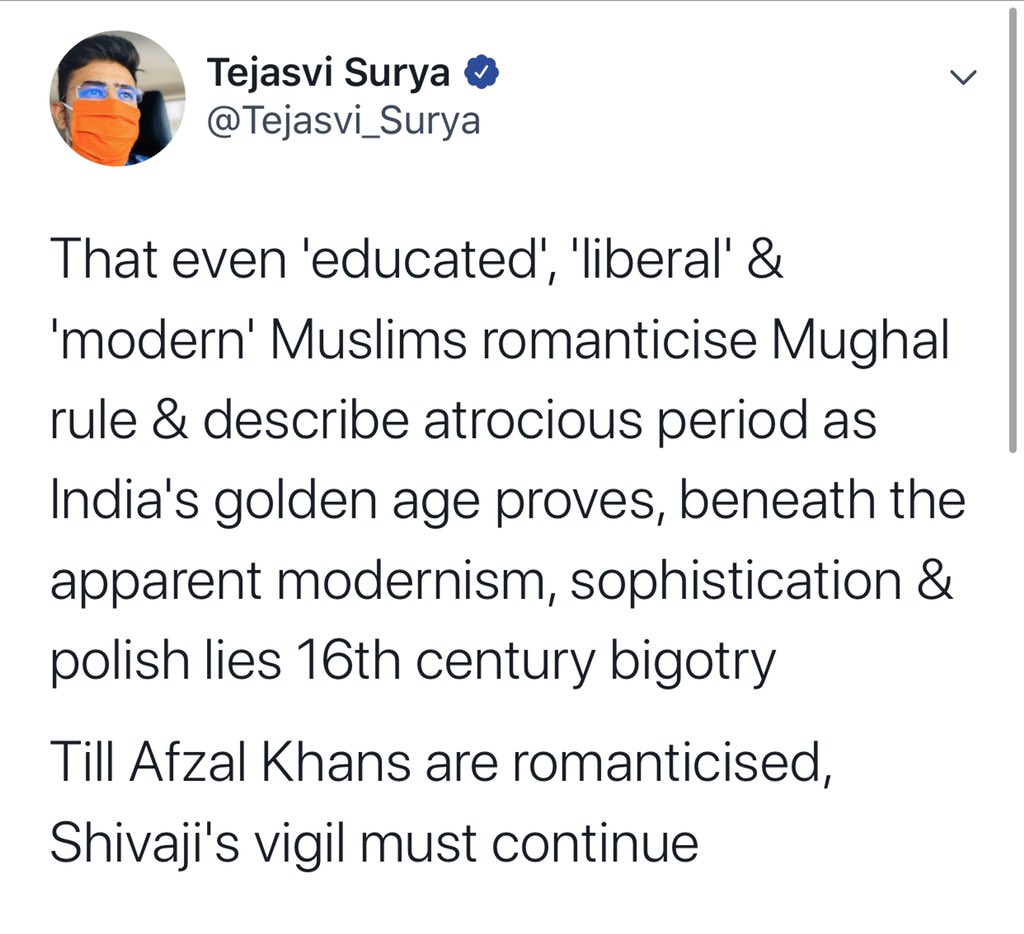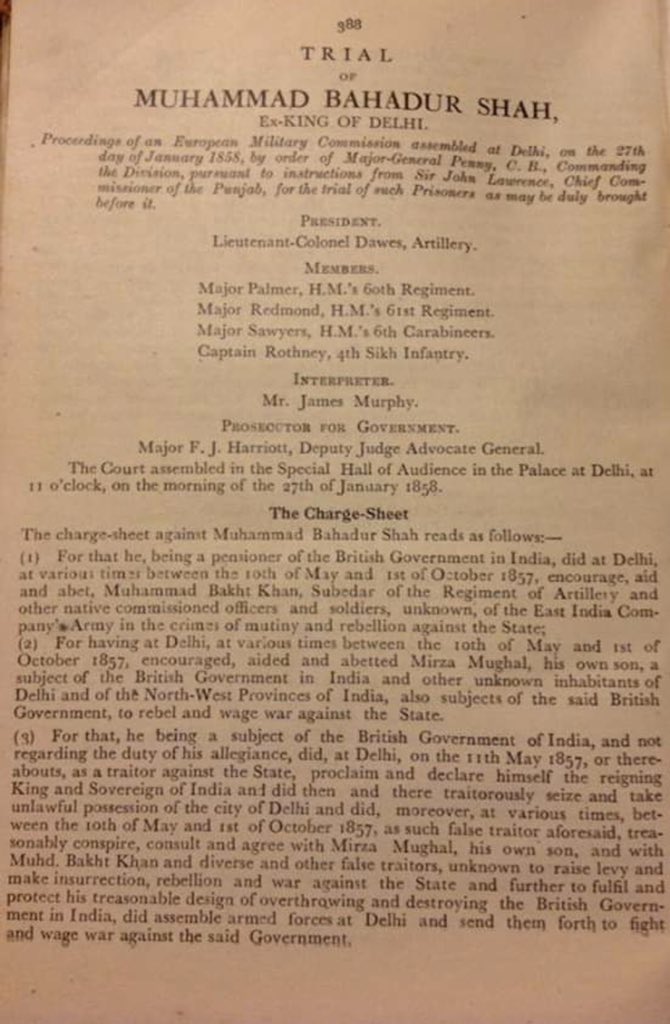Only an insecure citizen will vilify a period of history, as rich and complex as #Mughal rule.
This demonstrates a vacuum of confidence and an inherent inadequacy in their own ability, to accept or understand the dynamics that created modern #India.
A #thread on the #Mughals:
This demonstrates a vacuum of confidence and an inherent inadequacy in their own ability, to accept or understand the dynamics that created modern #India.
A #thread on the #Mughals:
1. The #Mughals, as they are erroneously called, were descended from Temur (aka Tamberlane, Tamerlane), in a direct patrilineal line and from Chengiz Khan in a direct matrilineal line.
They identified themselves with their Timurid heritage.
#TheGreatMughals
They identified themselves with their Timurid heritage.
#TheGreatMughals
2. Babur, like all Mughals felt a legitimate claim on Hindustan after its conquest in 1398-99, by Temür, which effectively ended the already tottering Tughlaq Sultanate, following the fall of Delhi.
Not until 1451 and the rise of the Lodis (under Bahlul Khan), did Delhi recover.
Not until 1451 and the rise of the Lodis (under Bahlul Khan), did Delhi recover.
3. Even Rajput chroniclers cite an agreement between Babur and Rana Sanga to dethrone Ibrahim Lodi, with Babur being invited to take Delhi while the Rana captured Agra. “Sanga hesitated to fulfil his part of the agreement.”
(See GN Sharma, “Mewar and the Mughal Emperors”, 1954.)
(See GN Sharma, “Mewar and the Mughal Emperors”, 1954.)
4. Following their success at Panipat and Khanua, the Mughals entrenched themselves into the former possessions of the Lodis.
This lasted for approximately 15 years until Sher Shah Suri drive Humayun to exile into Persia.
The #Mughals returned to India under Humayun in 1555.
This lasted for approximately 15 years until Sher Shah Suri drive Humayun to exile into Persia.
The #Mughals returned to India under Humayun in 1555.
5. Under Humayun’s son #Akbar (The Great), the #Mughal empire expanded, ushering in a “Golden Age”. Akbar created one of the largest centralised states in the world. He evolved and revolutionised Sher Shah’s blueprint into an administrative reality, one we still use today.
6. Apart from far reaching military evolutions and far reaching fiscal reforms, Akbar’s age was a “renaissance” for art, literature, architecture and craftsmanship; elements we know as culture.
He also unified Hindustan under a singular, centralised government.
#AkbarTheGreat
He also unified Hindustan under a singular, centralised government.
#AkbarTheGreat
7. Tulsidas wrote his Ramcharitramānas during the reign of Akbar and the famous Sankat Mochan temple in Benaras was expanded during his reign.
Akbar issued land-grants around the Golden Temple in Amritsar for its upkeep as well as to the Jain temples in Ranakpur, Rajasthan.
Akbar issued land-grants around the Golden Temple in Amritsar for its upkeep as well as to the Jain temples in Ranakpur, Rajasthan.
8. Akbar had the #Ramayana translated into #Persian, a copy of which he gifted to his mother - Hamira Banu Begum - whom he revered.
The Mahābharata (or Razmnāma), was also translated into Persian during Akbar’s reign. The study of #Sanskrit received imperial patronage.
The Mahābharata (or Razmnāma), was also translated into Persian during Akbar’s reign. The study of #Sanskrit received imperial patronage.
9. Akbar’s reign was also the time that the Guru Granth Saheb was compiled into an extant form.
So we have Jain seers, Sanskrit and its scholars, Sikh Gurus, Christian (Jesuit) missionaries, Parsi emissaries and of course Islamic orders receiving imperial patronage.
#Secularism
So we have Jain seers, Sanskrit and its scholars, Sikh Gurus, Christian (Jesuit) missionaries, Parsi emissaries and of course Islamic orders receiving imperial patronage.
#Secularism
10. The Ain-e-Akbari is considered a seminal compilation and chronicle, not only in Indian history but world globally, as a record of Akbar’s reign and administration.
Critics of the Mughal Empire May learn and benefit from even a cursory reading of this remarkable work.
#History
Critics of the Mughal Empire May learn and benefit from even a cursory reading of this remarkable work.
#History
11. Akbar’s reign also saw a flowering of a “ #Rajput Renaissance”, as many Mansabdars of the Empire, in Rajputana in particular, were able to turn their energies to cultural aspects.
The expansion of Amber is one example of the Mughal-Rajput synthesis that flowered in the 16th C.
The expansion of Amber is one example of the Mughal-Rajput synthesis that flowered in the 16th C.
12. By 1600, #India had the highest level of urbanisation in the world with Delhi boasting a population of over 500,00 and Fatehpur Sikri a population of 200,000.
A comparative with European cities is given below:
Paris: 200-300,000
London: 200,000
Rome: 100,000
Antwerp: 100,000
A comparative with European cities is given below:
Paris: 200-300,000
London: 200,000
Rome: 100,000
Antwerp: 100,000
13. By the 1650’s the only economy on the planet, competing with India was the Chinese; notably under the Ming Dynasty, until the fall of Peking in 1644. Under Akbar’s son Jehangir - at worst a sterile interlude - the #MughalEmpire consolidated and continued its expansion.
14. While Shah Jahan is best-known for a few buildings; you know, the odd Taj Mahal, Red Fort etc, few know about his development of maritime trade, which Portuguese chroniclers admit saw bullion flow into India, even while land routes to the west remained closed by the Safavids.
15. Globally, “India had the strongest economy in 1700, closely followed by #China.”
Below are some INTRODUCTORY links to the oft-debates subject of GDP under the #Mughals.
http://google.com/amp/s/www.live …
http://google.com/amp/s/m.econom …
http://warwick.ac.uk/fac/soc/econom …
http://newgeography.com/content/005050 …
Below are some INTRODUCTORY links to the oft-debates subject of GDP under the #Mughals.
http://google.com/amp/s/www.live …
http://google.com/amp/s/m.econom …
http://warwick.ac.uk/fac/soc/econom …
http://newgeography.com/content/005050 …
16. #Aurangzeb is perhaps the most misrepresented of all the #Mughal Emperors. In him the succeeding “Paramount Power”, the #British, found a ready villain - one of relatively recent memory - to vilify and this buttress the legitimacy of their own rule in India.
Yet few know...
Yet few know...
17. Aurangzeb used Islamic jurisprudence to extend centralisation over the largest Empire to cover the expanse of India.
While the enforcement of these laws was minimal his writings (mostly untranslated), have received maximum outrage and propagation for political reasons.
#Law
While the enforcement of these laws was minimal his writings (mostly untranslated), have received maximum outrage and propagation for political reasons.
#Law
18. Aurangzeb abolished the inland poll tax on the transport of goods within the Empire, to foster trade.
This used to be charged at 10% of the value of the goods being transported and its removal eased the economic life of all his subjects, though it burdened his treasury.
#Tax
This used to be charged at 10% of the value of the goods being transported and its removal eased the economic life of all his subjects, though it burdened his treasury.
#Tax
19. In 1664, #Aurangzeb issued an edict officially banning Sati - something Akbar had tried to do.
The practise was finally eradicated by the British in the 19th Century but Aurangzeb made it unlawful in his own reign.
#SocialReform
The practise was finally eradicated by the British in the 19th Century but Aurangzeb made it unlawful in his own reign.
#SocialReform
20. Even today, there is a quarter in the city of #Benaras, known as #Aurangabad, which Aurangzeb gifted to the #Brahmins of Kashi in perpetuity, to honour their learning and scholarship of Sanskrit.
This can be verified by a simple visit to the place.
This can be verified by a simple visit to the place.
21. Those who mention Shivaji Bhonsle at the drop of a hat, should realise that Mughal-Maratha relations were complex. They will do well to remember that Shahuji Bhonsle; grandson of Shivaji, was a #Mughal nobleman and took the assistance of Bahadur Shah I, to secure his throne.
22. It was not the #Marathas, nor the #Sikhs nor the Jats but a Parisian army, under #NadirShah that dealt the Mughal Empire it’s death blow at the battle of Karnal, in February 1739.
Following this, the authority of the Mughal Emperor was enfeebled, possibly beyond repair.
Following this, the authority of the Mughal Emperor was enfeebled, possibly beyond repair.
23. In a tweet shared earlier today by @IndiaArtHistory, we saw the charge-sheet prepared by the British against Bahadur Shah “Zafar”, in which he is accused of being “a traitor against the State.”
With his exile to Burma, in 1859, the Mughal Empire came to an end.
With his exile to Burma, in 1859, the Mughal Empire came to an end.
24. Public figures, especially representatives of the people in #Parliament may not be able to readily inform us about #History accurately; that is forgivable.
It is unforgivable that they should mislead and “mis-educate” the public about the facts of History, as they are.
It is unforgivable that they should mislead and “mis-educate” the public about the facts of History, as they are.
25. I urge my fellow citizens to see #History for what it is and not as a battle-ground to correct perceived historical injustices.
That will lead nowhere except, reducing knowledge and understanding about who we are, where we come from and why we are here.
Thank you.
That will lead nowhere except, reducing knowledge and understanding about who we are, where we come from and why we are here.
Thank you.

 Read on Twitter
Read on Twitter



